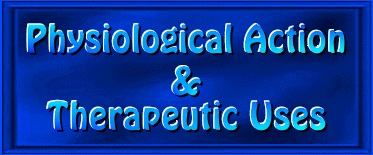

The following is excerpted from The Professional's Herbal Formula Handbook No. 4, comprising 73 pages of traditional information and recent scientific data that describes the medical properties, physiological action and therapeutic uses for each of the 24 ingredients outlined in this formula.




Adaptogenic, alterative, anabolic, anti-allergic, antibiotic, anti-cachexic, anti-dyscratic, antioxidant, antiphlogistic (anti-inflammatory), antipyretic, antiseptic, bacteriostatic (anti-bacterial), cytophylactic, cytotoxic, eutrophic, febrifuge, immuno-potentiating, immuno-stimulant, microbicidal (anti-microbial), rejuvenative, relaxant, stimulant (circulatory and secretolytic), respiratory tonic, tropho-restorative, vasodilator (bronchial and pulmonary) and viricidal (anti-viral).


Alleviates any general fluids dyscrasia (abnormal or pathological condition) within the mucous membranes throughout the upper respiratory tract (sinus cavities, bronchial passages and throat region) that leads to the onset of various forms of allergies or allergic reactions (including atopic, bacterial, bronchial, contact, drug, food, hereditary or pollen), and eliminates any form of cachexia (state of malnourishment and general debility) throughout the mucous membranes of the sinus cavities, throat and bronchial or nasal passages; relieves any common allergic reactions or immune-related disorders, including allergic asthma or rhinitis (hayfever), sinus congestion, sinusitis (inflamed sinus cavities), and psoriasis or other skin allergies; reduces any bronchial reactivity towards common allergens (such as dust or anemophile pollen) in those conditions involving allergies, asthma or sinusitis, due to the presence of a series of diterpene compounds (known as ginkgolides); relieves any acute respiratory distress syndrome, and acts as an anti-allergy agent in those conditions involving allergic asthma, urticaria (hives) and migraine or sinus headaches; exhibits cytophylactic and cytotoxic effects in order to increase cellular defense against any infection or infectious conditions, and displays significantly increased resistance towards any stressful conditions (particularly throughout the entire capillary system); displays bacteriostatic and microbicidal activity in order to strengthen and increase the resistance of the blood vessels against any invasive or harmful pathogenic bacteria or microbes throughout the bronchial and sinus mucosa, as well as to inhibit the further development of any inflammatory or infectious conditions associated with the onset of various allergies or allergic reactions throughout the bronchial and nasal passages; displays significant antiphlogistic activity in order to inhibit the formation of certain inflammatory compounds (such as histamine, leukotrienes, prostaglandin, serine proteases and thromboxanes), as well as to reduce any severe inflammatory swelling associated with various allergies or allergic reactions by exerting an extremely positive influence towards correcting any blood vessel or tissue inflammation and various other internal inflammatory conditions; reduces any inflammatory conditions in the blood vessel walls, and acts as an inflammatory autacoid in order to mediate any local tissue response (such as pain perception, blood coagulation and smooth muscle contraction); accelerates the healing process during various inflammatory conditions, while reducing any fevers or feverish states; enhances many inflammatory and allergic processes, such as neutrophil activation, increased vascular permeability, smooth muscle contraction (including broncho-constriction) and reduced coronary blood flow; exhibits significant antiseptic activity by destroying the vitality of any organized living ferments in order to prevent the onset of putrefaction or septicemia, and precipitates the proteins in any inflamed tissues in order to provide a mildly antiseptic and protective coating (under which the regeneration of new tissue occurs) for the mucous membranes throughout the entire respiratory system; acts as an effective antiseptic in order to remove any septic conditions associated with tissue degeneration or ulceration, and promotes increased suppuration and a steady toning or restorative impression to the entire glandular system (especially the liver and lymph glands); exerts profound general tissue effects, including antioxidant, membrane-stabilizing, and free-radical scavenging activity (especially throughout the central nervous system), and acts as an extremely effective inhibitor of any lipid peroxidation in various cellular membranes that is induced by oxygenated free radicals; displays powerful antioxidant properties in order to prevent or reduce any systemic organ or cellular damage from excessive accumulations of potentially dangerous chemical substances (known as free radicals) throughout the system that are generated during any chronic activation of the immune system, and protects against any tissue or organ damage caused by environmental toxins (such as pesticides or herbicides); prevents any free-radical damage to the myelin insulating sheath surrounding the nerves, brain cells, and various tissues or organs throughout the body, due to the presence of heteroside flavonoids (quercetin, kaempferol and isorhamnetin), coumarin esters of quercetin kaempferol and glucorhamnoside, iodized flavonoids (proanthocyanidins) and catechins; enhances all the vascular, rheological, metabolic and immunological functional capabilities, and directly contributes to the metabolic (anabolic and eutrophic) health of the various cells throughout the body; exhibits anabolic activity in order to accelerate the production of DNA and RNA (which enhances the production of proteins in the form of antibodies), while increasing protein and lipid synthesis in the bone marrow and DNA/RNA content in the adrenals and lymph nodes (along with increased body weight and enhanced re-synthesis of glycogen and high-energy phosphate compounds); demonstrates powerful adaptogenic (balancing and strengthening) activity in order to provide greater resistance towards many physical or chemical agents and various allergic or infectious conditions, as well as greater reinforcement to the body in relation to its ability to deter any external aggressive bacterial or viral agents during the onset of allergies; exhibits immuno-potentiating and immuno-stimulatory effects in order to enhance greater long-term immune potential and overall non-specific systemic immunity (or immune cell activity) and increased immune response (by activating the body's natural defense mechanisms), particularly in relation to the repair and restoration of any damaged or congested blood vessels, tissue-systems or mucous membranes throughout the upper respiratory tract; inhibits the platelet activating factor (PAF-acether) from over-stimulating the immune system by activating various immune cells (neutrophils, eosinophils and macrophages) or endothelial cells, which can ultimately lead to asthmatic conditions, bronchial reactivity, and toxic shock syndrome from bacterial sepsis or septicemia (poisoning); displays potent inhibitory effects against the platelet activating factor (known as ginkgolide B > A > C) by competing with PAF-acether for binding (receptor) sites, and inhibits the various events induced by PAF-acether (including calcium influx and phospholipase activation); stabilizes the platelet cellular membranes (which are fluid barriers or defensive mechanisms against cellular invasion) in order to inhibit platelet aggregation (blood-thinning capabilities), adhesion and degranulation, due to direct membranal or antioxidant effects, increased synthesis of prostacyclin, inhibition of the enzyme phosphodiesterase, and the antagonism of the platelet activating factor (PAF-acether); stimulates the synthesis of prostacyclin, which is the natural anti-aggretory prostaglandin that is synthesized by the vascular endothelium (the cells that line the inside of the blood vessel); exhibits a direct effect upon endothelial cells in order to enhance greater blood flow in both the arteries and veins without any alteration in systemic blood pressure, and inhibits the release of certain enzymes in such a manner that leads to smooth muscle cell relaxation in the walls of the blood vessels; displays vasodilator activity by direct stimulation of the release of endothelium-derived relaxing factor (EDRF) and prostacyclin, and demonstrates vascular effects primarily by directly affecting the cells that line the walls of the blood vessels; enhances the tonicity of the smooth muscle cells in the blood vessels, and provides greater tonification to the vein that is essential to the dynamic elimination of various toxic metabolites that accumulate during lowered oxygen levels; alleviates any intermittent claudations (painful leg cramps) associated with arterial insufficiency (reduction of blood flow to a specific area) that leads to oxygenation deficiencies (hypoxia), which increases the production of toxic metabolites and cellular free radicals; prevents the formation of any metabolic or neuronal disturbances in those conditions involving cerebral ischemia and hypoxia by enhancing the utilization of oxygen and increasing the cellular uptake of glucose, thereby restoring aerobic glycolysis; increases the number of cholinergic receptor sites in the brain in order to revitalize any decreasingly ineffective cerebral tissue, and enhances greater cellular energy-production by beneficially affecting the various intracellular components; activates the membranal enzyme Na + K + ATP - ase (or sodium pump) that is responsible for the exchange of intracellular sodium for extracellular potassium, thereby improving the membranal polarization process (which is extremely important in excitable nerve tissues); increases the rate at which information is transmitted at the nerve cell level, and improves the availability and synthesis of the chemical neuro-transmitters acetylcholine and dopamine in order to enhance greater longevity; stimulates the release of various chemical neurotransmitters known as catecholamines (namely, epinephrine and norepinephrine), thereby improving the functional capabilities of the entire network of catecholaminergic glandular, cardiovascular and nervous systems; acts as a secretolytic stimulant in order to promote increased gastric, pancreatic or intestinal secretory and motor activity, and enhances greater peripheral circulation (due to its antioxidant activity); exhibits significant antioxidant effects in order to provide greater oxygen-transport capabilities throughout the bloodstream, as well as enhance the transport of additional oxygen directly into the cells and tissue-systems throughout the entire organism; acts as a circulatory stimulant by increasing the blood flows through the arteries and blood vessels of the upper respiratory tract in order to enhance greater nutrient transport, absorption and utilization, thereby accelerating the healing processes associated with the repair of any damaged mucous membranes or tissue-systems throughout the sinus cavities, throat and bronchial or nasal passages; displays alterative activity in order to correct any disordered bodily function, thereby activating increased alterations in both metabolic and tissue functions as a defensive measure against the onset of acute or chronic disease; exhibits restorative effects in order to regain increased vigor or vitality and greater strength, while enhancing normal tissue and metabolic functional capabilities; demonstrates alterative and restorative properties in order to re-establish healthy systemic functional capabilities, as well as to establish greater vascular tone throughout the entire organism (due to its ability to stimulate increased secretory flows); exhibits alterative effects in order to stimulate the anabolic growth processes, thereby enhancing the repair of any degenerated, deteriorated and debilitated cells or tissues (while promoting the elimination of any catabolic waste materials); displays tonifying effects in order to permanently enhance the overall energy-levels throughout the entire organism, without adversely affecting the functional capabilities of any particular organ or system.
![]()
None.
![]()